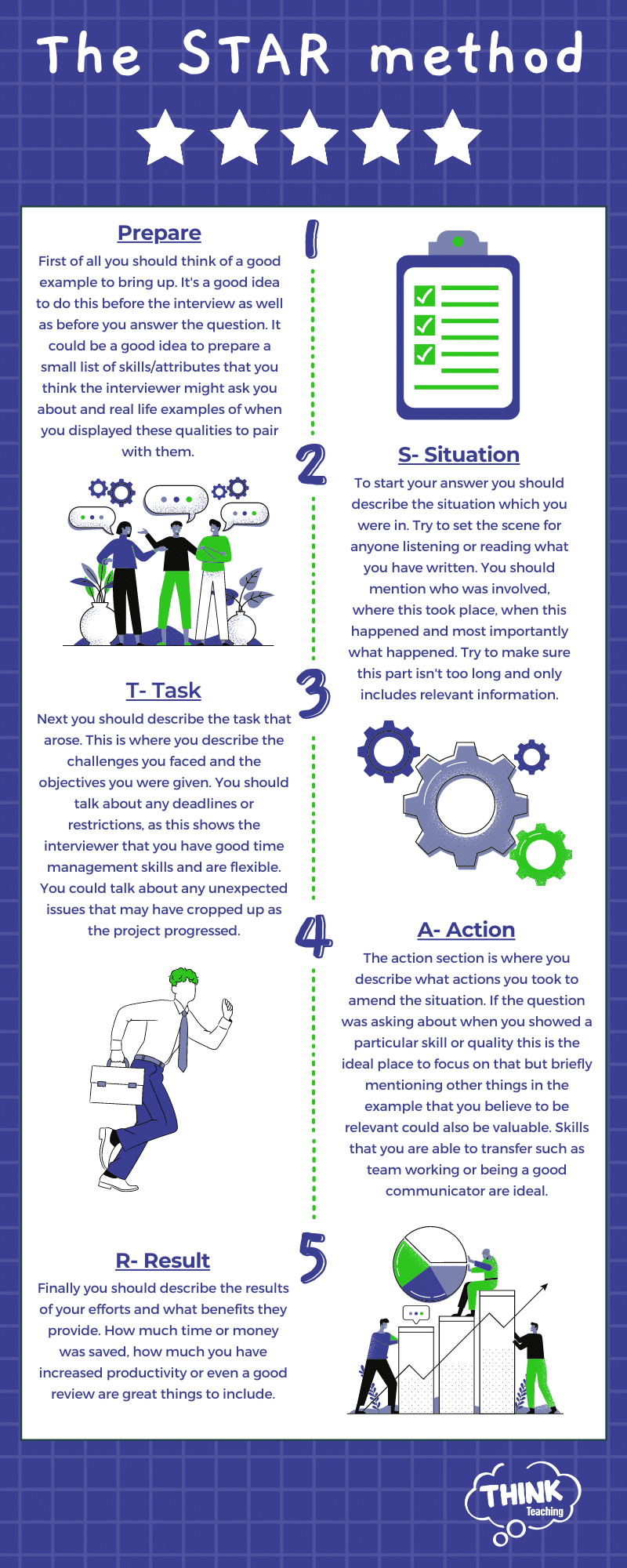When should you use the STAR method?
The STAR method can be used when writing cover letters, answering questions on job application forms and even writing CVs, but is particularly useful when answering behavioural interview questions. Behavioural interview questions require candidates to share examples of situations they have been in where they have shown certain skills. You can tell a question is behavioural as it usually has an opening like:
- Recall a time when…
- Have you ever…
- Give an example of…
- Describe a time…
- Tell me about…
As you can see these are all asking you to recall, describe or talk about a real life experience. When answering questions like this it can be easy to start rambling or go off on a tangent but the STAR method endeavours to fix that. The STAR method is used to help structure real life examples in a way that will help show off your best qualities.
What does STAR stand for?

How to use the STAR method

First of all you should think of a good example to bring up. It’s a good idea to do this before the interview, but be ready to come up with new examples if the interviewer is looking for something specific. It could be a good idea to prepare a small list of skills/attributes that you think the interviewer might ask you about and the real life examples of when you displayed these qualities to pair with them.
To start your answer you should describe the situation which you were in. Try to really set the scene for anyone listening to you or reading what you have written. You should mention who was involved, where this took place, when this happened and most importantly what happened. Try to make sure this part isn’t too long and only includes relevant information.
Next you should describe the task that arose or was set in front of you. This is where you describe the challenges you faced and the objectives you were given. You should talk about any deadlines or restrictions you were put under, as this shows the interviewer that you have good time management skills and are flexible. You could talk about any unexpected issues that may have cropped up as the project progressed.
The action section is where you really start to answer the question you’ve been asked by describing what actions you took to amend the situation. If the question was asking about when you showed a particular skill or quality this is the ideal place to focus on that but briefly mentioning other things in the example that you believe to be relevant could also be valuable. Skills that you are able to transfer such as team working or being a good communicator are ideal.
Finally you should describe the results of your efforts and what benefits they provide. If using STAR for a CV, cover letter or application form providing statistics of the benefits of your actions would be ideal. How much time or money was saved, how much you have increased productivity or even a good review are great things to include.
Tips for using the STAR method
- Try to keep your answer short and concise. Even when using the STAR method too much irrelevant detail will only make your answer worse.
- Try to keep your answer conversational and don’t sound too rehearsed. Though planning and thinking about your answer before hand is a good thing, coming across as robotic as opposed to natural will only hurt your chances.
- Though using examples from time at work will likely be more valuable there is nothing wrong with talking about examples from your time in education, examples from home or examples in hobbies you have.
- You should prepare to answer more questions about the example you have presented to the interviewer.
- Most importantly of all you should make sure to tell the truth. Being caught out lying by the interviewer will ruin your chances when trying to get the role.
Example of the STAR method using previous work
Question: Have you ever had to deal with multiple tasks at work?
Situation: I was working as a school receptionist at my previous job. Within the space of 5 minutes I received 2 emails, both assigning me different tasks alongside my other responsibilities.
Task: One email was from the headteacher asking me to do some data entry by the end of the week. The next email was the head of history, they had an IT problem in their department and needed some worksheets photocopying to take into the account the change, this was time sensitive as the lesson was ongoing. I also had to greet any visitors to the school and deal with any enquiries they might have.
Action: Firstly, I made sure to tell everyone involved about the sudden influx of tasks so they could plan around any delays and kept them up to date as to when I would be able to assist them. Even though one of the tasks was set by the headteacher, I decided that dealing with the photocopying was an imminent concern as this could hold up teaching for hundreds of pupils and the data entry was much less time sensitive. After I completed the photocopying, I manned the front desk and began the data entry task, breaking away to complete my other duties when they arose.
Result: As a result of this I was able to fulfil my usual role while also completing the data entry task. The headteacher told me I had done a good job with the data entry and that I didn’t make any mistakes. The head of the history department told me due to my quick action with the photocopying the lessons were not interrupted and no learning time was lost.
Example of the STAR method using previous learning
Question: Recall a time when you had trouble working with co-workers or group members.
Situation: I was taking a Level 2 Teaching Assistant course in preparation for a career as a teaching assistant and I was assigned to do a group project with another learner.
Task: The other learner was reluctant to contribute to the project due to a lack of confidence with their writing skills. The project had a deadline of 2 weeks so this needed to be resolved in good time.
Action: I approached the other learner and we discussed the issue. We came to the decision that it would be best if they focused on elements of the project they felt more comfortable doing. So I took the initiative and assigned the other learner more suitable tasks.
Result: We were able to finish the project with a few days to spare, meaning we could polish our work and check for any mistakes. We achieved a mark of 100% on the paper and received congratulations from our tutor.
Example of the STAR method using hobbies
Question: Tell me about a time when you have displayed leadership skills.
Situation: I am a player in an amateur local football team.
Task: Our captain was taken ill so we had no leader for that season.
Action: I decided to step up and fill in for our captain. I organised our training meetups, matches with other teams and endeavored to keep our spirits high.
Result: For my efforts we not only got to the final that season but I was given the more permanent role of assistant captain when our captain had recovered.
Examples from a work environment are often the most valuable when using the STAR method so checking out our jobs board could be great way of getting the experience you need! Having trouble getting to the interview stage? Try boosting your CV with some of our online courses.







